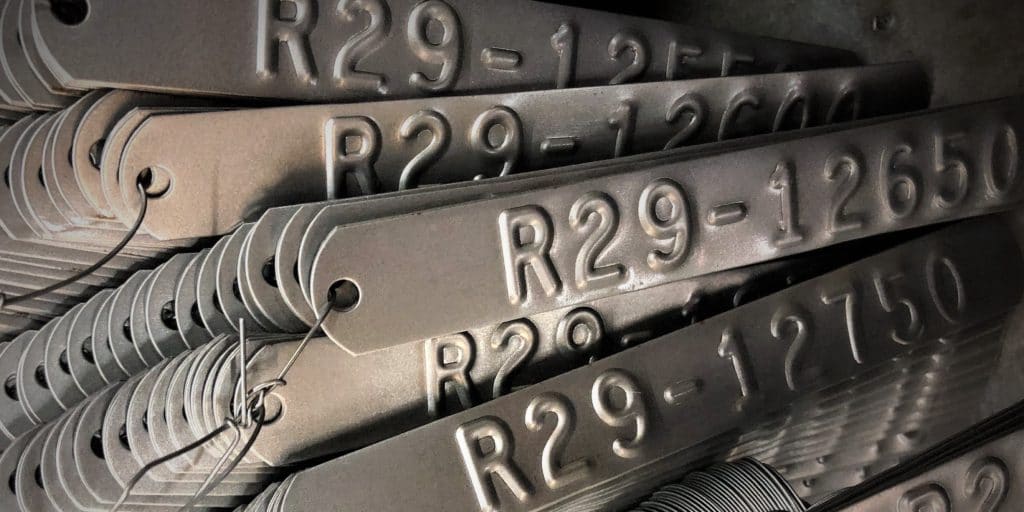Labeling chemicals accurately is one of the best ways to prevent serious accidents in the workplace. It’s also required under federal safety regulations. Because chemical labels are used to communicate information about potential hazards, it’s essential to order high-quality labels that can be customized with your company’s name and address. Metal Marker Manufacturing Company offers a wide variety of custom identification products, making it easy to meet your legal and ethical obligations. We put together this guide to understanding chemical labels to help you determine what information to include on each label you order.

What Are Chemical Labels?
The Occupational Safety and Health Administration (OSHA) enforces the workplace safety rules outlined in Title 29, Part 1910 of the Code of Federal Regulations. One of the most important rules relates to the use of labels to communicate important safety information to employees, vendors and other stakeholders. Under OSHA’s Hazard Communication Standard, hazardous chemicals must be labeled with precautionary statements, signal words and pictograms to ensure anyone who handles them is aware of the potential dangers.
Understanding chemical labels starts with recognizing their basic components. At minimum, hazardous chemical labels must contain the following information:
- Contact information for the manufacturer or shipper
- Product identifier
- Signal words
- Hazard statements
- Precautionary statements
- Pictograms, or graphic symbols used to communicate information about the hazards associated with a chemical
Why Are Chemical Labels Important?
Using hazardous chemical labels has many benefits for employers and employees. For employers, applying appropriate labels to each chemical container helps prevent costly workplace accidents and reduces the risk of being fined by OSHA for failure to comply with the Hazard Communication Standard.
Employees who work with hazardous chemicals can look at the label and know within a few seconds what type of danger a chemical represents. The bright colors and graphic symbols of hazardous chemical labels make it much easier to know what precautions an employee needs to take to avoid chemical burns, fires and other serious accidents. Chemical labels also contain hazard statements to help employees understand what might happen if they don’t handle or store a chemical in a safe manner.
The bottom line is that understanding chemical labels help companies comply with federal safety rules, reduce workers’ compensation costs and prevent accidents that can destroy warehouses, manufacturing facilities and other valuable assets.

Understanding Chemical Labels: A Guide to Each Component
Once you know the six components that must appear on a chemical label, it’s important to understand what each one entails and how it can protect your company and its employees. Understanding chemical labels takes a little effort, but once you know how to do it, you’ll be able to comply with OSHA standards, prevent serious accidents and keep your employees safe on the job.
Product Identifier
The product identifier is the name or number used to identify a hazardous chemical. Depending on what type of chemical you’re labeling, the product identifier may be a common name, chemical formula, brand name or part number. To comply with OSHA guidelines, the product identifier on the label must match the product identifier listed on the chemical’s safety data sheet.
Signal Words
Signal words are short phrases used to let handlers know about potential hazards. Under OSHA’s Hazard Communication Standard, only one of two phrases can be used on each label. “Danger” is used for the most severe hazards, while “Warning” is used for less severe hazards.
Hazard Statements
Hazard statements describe the type of hazard associated with the chemical, along with its potential severity. Hazard statements can be used to describe physical, health or environmental hazards. The following are examples of the statements used for physical hazards:
- Unstable explosive
- May mass explode in fire
- Extremely flammable gas
- Self-heating; may catch fire
- Contains gas under pressure; may explode if heated
- May be corrosive to metals
These are some of the most common statements for health hazards:
- Toxic if swallowed
- May be harmful in contact with skin
- Causes severe skin burns and eye damage
- Causes serious eye damage
- Harmful if inhaled
- May cause respiratory irritation
- May cause genetic defects
- Suspected of causing cancer
If a company needs to communicate information about environmental hazards, the label needs to contain a hazard statement disclosing the potential effects of each substance on the aquatic environment. Common statements include “Very toxic to aquatic life” and “May cause long lasting harmful effects to aquatic life.”
Precautionary Statements
Precautionary statements tell employees, vendors and shippers what they need to do to protect themselves from chemical hazards. A precautionary statement can be used for prevention, response, storage or disposal; for example, a response statement tells handlers what they need to do to minimize the harmful effects of the substance if there’s a spill or some other type of exposure. Here are some examples of precautionary statements used on chemical labels:
- IF ON SKIN: Rinse immediately contaminated clothing and skin with plenty of water before removing clothes. Wash contaminated clothes before reuse.
- If swallowed, immediately call a poison control center.
- In case of fire, use water spray. In case of major fire and large quantities: evacuate area.
- Do not eat, drink or smoke when using this product.
- Dispose of contents in accordance with local regulations.
Pictograms
Understanding chemical labels is much easier when each label contains a pictogram — a set of symbols used to communicate information about hazards as quickly as possible. Instead of having to read several pages of safety data, an employee just has to glance at a pictogram to know what kind of hazard is present. Pictograms can be used to alert employees to carcinogens, flammable substances, oxidizers, explosives and other hazardous materials.
A strong safety culture starts with a commitment to OSHA compliance and a desire to alert employees to potential hazards in the workplace. If you need custom chemical labels for your business, Metal Marker Manufacturing Company can help. Call (800) 428-0095 to inquire about our chemical labels and other custom identification products.